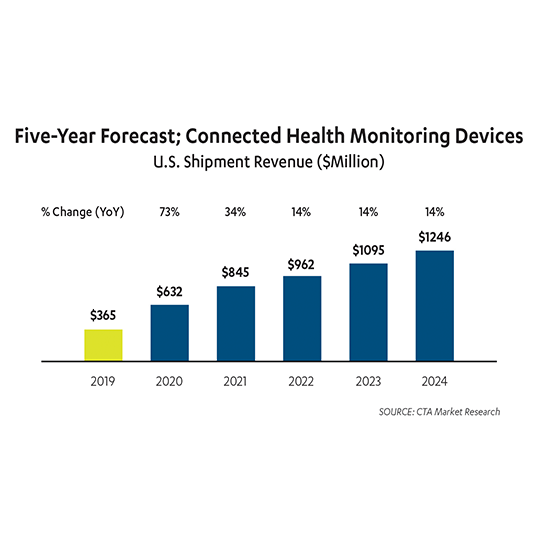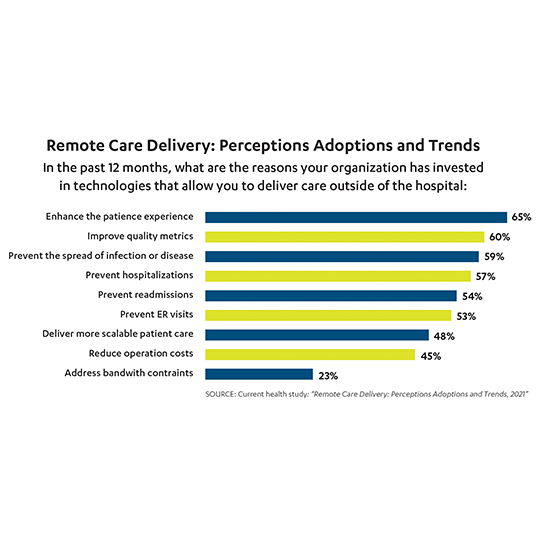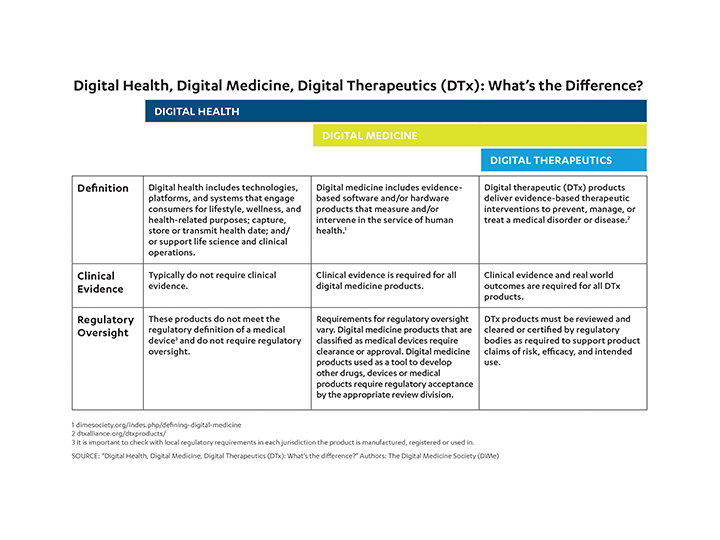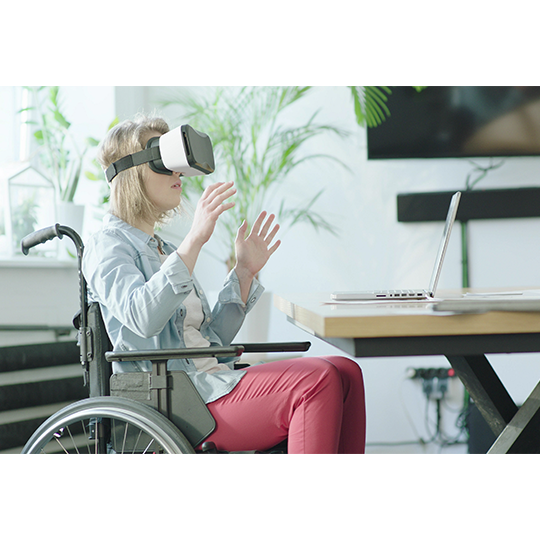
Creating Definitions
The current challenge is the multiple terms used within the industry. To date, the digital therapeutics field does not have a standard lexicon. There is no common industry definition of a digital therapeutic. It’s been described by Kerri Haresign, CTA director, technology and standards, as a kind of leading edge for CTA. “We look at that term in the context of the broader ecosystem of digital health. The goal is to set an industry standard on the common use and application of this technology, and educating consumers in the process,” she said.
Haresign added, “Many of us have a step counter whether it’s a Fitbit or an Apple Watch to encourage us to lose more weight and track our activity. But let’s say there’s somebody who is diabetic and their doctor said they have to walk two miles per day in order to keep their diabetes in check. In that case, then, the fitness tracker, if it’s used for the purpose of treating a disorder, would be considered a digital therapeutic device because it’s used in that kind of targeted application.”
All products claiming to be a digital therapeutic must adhere to these foundational principles:
• Prevent, manage, or treat a medical disorder or disease.
• Produce a medical intervention that is driven by software.
• Incorporate design, manufacture, and quality best practices.
• Engage end users in product development and usability processes.
• Incorporate patient privacy and security protections.
• Apply product deployment, management, and maintenance best practices.
• Publish trial results inclusive of clinically-meaningful outcomes in peer-reviewed journals.
• Be reviewed and cleared or certified by regulatory bodies as required to support product claims of risk, efficacy, and intended use.
• Make claims appropriate to clinical evaluation and regulatory status.
• Collect, analyze, and apply real world evidence and/or product performance data.
Source: Digital Therapeutics Aliance (dtxalliance.org)

One of the things that would be included in any upcoming definition is that it must be evidence-based. It could be a digital solution that is used in conjunction with a traditional pharmaceutical or medical solution. “So, again,” said Haresign, “using this example, you may think about a therapeutic device as you would think about a traditional drug treatment, which is going to have evidence of how it helped to solve a problem.”
Consumer tech and digital health companies are joining a new push for industry-wide digital therapeutics standards. CTA has been working with a number of health technology companies in developing these standards.
Haresign said, “CTA is uniquely placed to help drive this conversation and definition because we have a very diverse set of stakeholders sitting at the table. Within CTA we have leading digital health companies and some companies that are really purely digital therapeutics solution providers. And then, of course, working with CTA comes with the big digital tech firms as well.”
CTA member interest in DTx products stems from the fact that the software is accessible through devices such as smartphones and tablets. From the patient perspective, DTx offers convenience and privacy. That many are available only via prescription also positions the healthcare provider to play an active role in administering DTx therapies and in patient monitoring and outcomes assessment.
CTA’s initiative is not the only group to push for consistent standards. “An organization that’s been engaging with us directly is the Digital Therapeutics Alliance,” said Haresign. “CTA is a very collaborative organization, so we welcome others that want to to come to the table. We have sent some outreach to the regulators, for example, to give us input.”
CTA and the Connected Health Initiative are leading the Health Equity and Access Leadership (HEAL) Coalition.

A Booming Market
The surging prevalence of chronic conditions combined with long term effects of the pandemic is fueling growth in the booming global DTx market. According to a reportlinker.com study entitled Global Digital Therapeutics Industry the global market for digital therapeutics was estimated at US$347. 2 million in the year 2020 and is projected to reach US$1.6 billion by 2027, growing at a CAGR of 24.6% over the period 2020-2027.
However, Pitchbook includes digital therapeutics under the umbrella of “virtual health.” It states the global digital therapeutics market is currently valued at $2.1 billion and expected to reach $11.1 billion by 2025 at a CAGR of 26.8% (March 2021 for Q4 2020).
CTA and the Connected Health Initiative are leading the Health Equity and Access Leadership (HEAL) Coalition, a multi-sector initiative of tech companies, health care providers and public agencies examining new ways to leverage technology to reduce health disparities across diverse demographics and communities. The group’s first project will be a white paper with policy and operational recommendations on technology’s role in tackling disparities in the American healthcare system.
According to a report by the IQVIA Institute for Human Data Science Digital Health Trends 2021: Innovation, Evidence, Regulation, and Adoption, over 250 such products are now identified, including about 150 products commercially available (the rest are in development). So far, at least 25 digital therapeutics have been granted market authorization by the Food and Drug Administration, according to the report. Another 23 are commercially available, with some behavioral health apps exempted from FDA requirements to submit a 510(k) premarket notification during the pandemic. The IQVIA report identified 89 digital therapeutics still in development.
Furthermore, apps are increasingly focused on helping consumers manage their health conditions rather than on wellness management. Consumer disease management apps now account for 47% of the most widely used digital health apps in 2020, up from 28% in 2015. Apps for mental health, diabetes, and cardiovascular care account for almost half of the disease-specific apps. Simultaneously, digital therapeutics and digital care products Incorporating software as a means to treat, prevent or manage specific diseases or conditions are growing in volume and gaining reimbursements.
Also encouraging are suppliers such as Happify recently announcing new products, in this case Ensemble, a transdiagnostic prescription digital therapeutic for the treatment of patients who have Major Depressive Disorder (MDD) or Generalized Anxiety Disorder (GAD). Designed as an adjunct to care for MDD and GAD, Happify’s Ensemble is accessible via smartphone or computer, and teaches patients new skills and habits to take control of their anxiety and depression.
“Data shows that people with MDD are 5.7 times more likely to have GAD than people without MDD. Additionally, 20% of people with major depressive disorder also meet criteria for GAD in a given 12-month period,” said Chris Wasden, Head of DTx at Happify Health. “With mental health disorders exploding as a result of the pandemic, significant shortages of mental health clinicians, high costs of treating mental health disorders, and a high degree of variability in applying Cognitive Behavioral Therapy, mindfulness, and positive psychology to treat these patients, clinicians need an evidence-based therapy like Ensemble.”
Similarly, Ginger has announced on-demand mental healthcare access for adolescents. Ginger for Teens will provide individuals ages 13-17 with access to Ginger’s self-guided content, 24/7 on-demand and scheduled coaching and video therapy and psychiatry sessions. Ginger for Teens aims to provide adolescents with mental health support through a smartphone. The Ginger app will be available to adolescents by invitation from a parent who is eligible for Ginger as a benefit through their workplace. Over 25 million people in over 50 countries around the world have access to Ginger through employers, health plans, and partners. This offering will be available to all Ginger clients and members by 2022.


Treating Pain
Chronic pain is the number one cause of long-term disability in the United States and affects more Americans than diabetes, heart disease, and cancer combined. Delivering personalized guidance to patients with chronic pain can help them better manage their condition and improve their resiliency.
Software developed by Finnish drugmaker Orion is aiming to address chronic pain conditions using virtual reality (VR) devices that provide a game-like therapeutic treatment program. In a clinical trial Orion’s treatment has shown statistically significant benefit over passive (placebo) control and standard care interventions for fear of movement, patient clinical global impression of change (PGIC) and quality of life in adult patients with chronic low back pain (CLBP).
The therapy uses a VR headset to guide people with chronic pain through a series of cognitive behavioral therapy (CBT) exercises designed to help them overcome the fear of movement – also known as Kinesiophobia — and then re-engage in an active life. The modules are presented in a personalized mode that can be tailored to the patient’s needs. Orion developed the software in close collaboration with Professor Christopher Eccleston, a pain specialist from the University of Bath, and technology group Healthware. Results from Orion’s pilot study ‘VIRPI’ were announced at the IASP 2021 Virtual World Congress On Pain.
Virtual reality can help airmen and soldiers self-regulate stress and brain waves to manage mental well-being. Healium, a CTA member and CES 2019 AARP Pitch Competition winner, leverages AR/VR and the body’s electricity waves to combat mental health concerns and stress.
Healium has been awarded a U.S. Air Force contract to explore deploying its mental fitness products to service members. Healium products allow users to biometrically alter their virtual environment through emotions and subsequently decrease their own stress. Powered by the user’s brain patterns and heart rate, the product lets users heal by promoting the user’s positivity and sensations of healing.
Healium products allow users to biometrically alter their virtual environment through emotions and subsequently decrease their own stress.
As the user reaches different states of focus or quiet of the mind, the Healium headband picks up the brainwave pattern changes and powers the VR experience forward. As the accompanying smartwatch picks up the decreasing heart rate, the AR environment will also adjust accordingly.

Focus on Stress
“Going forward,” said Haresign, “CTA is looking at standards for stress monitoring solutions and proposed requirements targeted at acute stress applications. Obviously, mental health is a huge topic and of huge interest. We know now — after the last year and a half — it is an opportunity for CTA to be a leader on this and to use data to identify some of the common best practices in the field.”
“Specifically with mental health,” Haresign continued, “CTA wants to focus in on chronic stress. We see it as an opportunity for technology to really change the space. So our standard is going to look at a number of different things, outside of doing some definitional work as we often do, to look at what are some of the factors or the metrics to think about as we develop some of these solutions.”
CTA is expecting a standard to come out on this topic in early 2022 covering characteristics and requirements for mental health technology solutions. It will provide guidelines and implementation for consumer technologies related to the monitoring, treatment, and diagnosis of mental health and mental wellness.